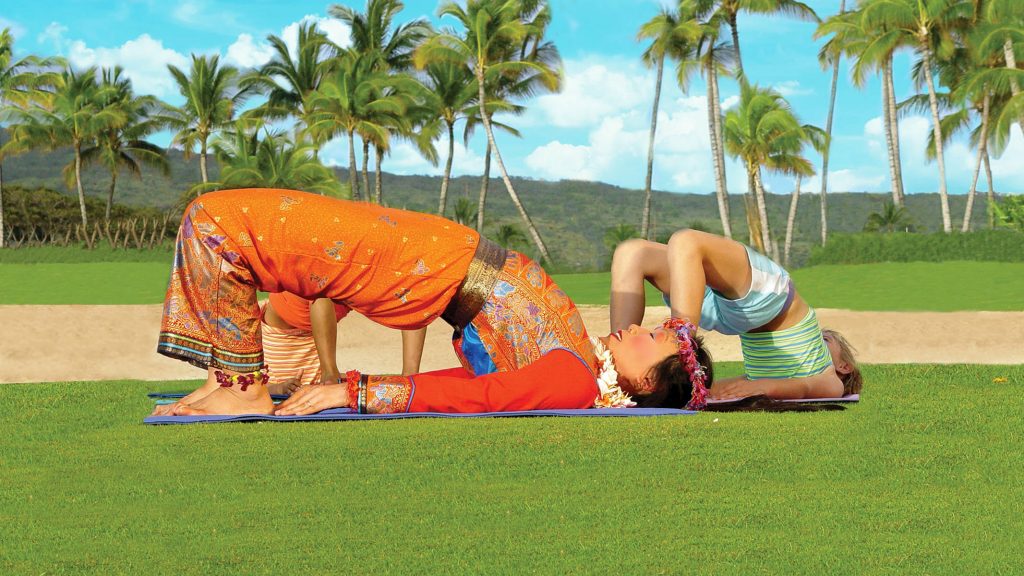We often hear new yoga asana practitioners sharing their experiences of going to a yoga studio and feeling discouraged or a bit embarrassed as they watch others arch high into a graceful backbend or achieve beautiful form in a pose. These newbies sometimes feel they are the odd one out, and they become disheartened because they are unable to do the poses with such ease and grace. Does this mean yoga is not for them? Isn’t it helpful to compare ourselves with others to help us be motivated to do better? In other words, is yoga meant to be competitive?
To find the answers to these questions, we asked renowned yoga icon Wai Lana about what is the real meaning of yoga.
Q: What is yoga?
A: While some people think of yoga simply as physical exercise, it is actually a complete, holistic system for overall health and well-being. This yoga system has been practiced for thousands of years and includes everything from physical postures (asanas), personal hygiene, and a healthy diet to premeditation, breathing, and relaxation techniques. The most advanced forms of meditation and self-realization are also a part of yoga. Many thousands of years ago, yoga asanas were scientifically developed to keep the body in a healthy, balanced state—one conducive to inner peace, creativity, and meditation.
Q: What do you have to say about yoga practitioners comparing themselves with other students?
A: In many yoga asana classes, it is very common for students to look at the person beside them to see how far the other is twisting and bending. They think, “Oh that person twisted 10 inches. I only twisted 2 inches.” Classes like this are always full of tension and may even result in injuries because of the competitive atmosphere. One of the objectives of yoga asanas is to relieve you of tension and heal your body of minor ailments, not worsen your stress and cause you injury.
Q: Is yoga competitive?
A: Yoga is simultaneously noncompetitive and competitive. While practicing yoga you should never compete with another person. You should not judge yourself by how far another person is stretching or how long he or she holds the pose and so on. I know some people who use their ability at yoga asanas to impress others. They become yogi show offs and there are people who look at them and say “Geez, I wish I could be as good as they are.” It reminds me of what my spiritual teacher once said, “Monkeys are more agile and flexible than even the best hatha yogis, but their consciousness is far from the yoga consciousness.” So to be a successful practitioner of yoga you must transcend that kind of competitiveness in your practice.
Q: So how do we improve in practicing asanas if we are not competitive?
A: Yoga practice does involve a type of competition, but you are not competing against another person, rather you are competing against your own physical and mental obstacles. On the physical level, you compete against laziness, inertia, tightness and so on. Mentally, you may compete against impatience, lack of confidence, or procrastination. So forget about competing with anyone else. You will do far better at yoga if you learn to compete against and beat your own personal obstacles.
Q: What do you have to say about the yogi show-offs?
A: This desire for recognition reveals an agitated mind and a sense of false pride—not the signs of a real yogi. True yogis are humble. They may not be doing extreme backbends or advanced balancing poses; in fact, they may not be practicing asanas at all. But because they have achieved inner peace and calm through meditation, they have attained yoga’s higher goal.
Q: Regarding this competitive nature, do you have any words for young practitioners?
A: Asanas should not be practiced in the spirit of competition nor should they be performed for the entertainment of others. They should be practiced only for our own well-being. This is especially important to remember when doing more advanced asana routines. Stay in tune with your body and progress step by step, allowing your body time to adjust to its expanding limitations. I always reiterate to all my students that doing yoga asanas is not a competition. You simply need to go as far as your body can go, according to its own condition. This means you need to feel and listen to your body. In this way, you will be careful and sensitive and you will not push yourself beyond your limits. Do not worry if you can’t twist as far as the other person or if you can’t stand on your head like the person beside you. It is irrelevant. A broom stands on its head!



